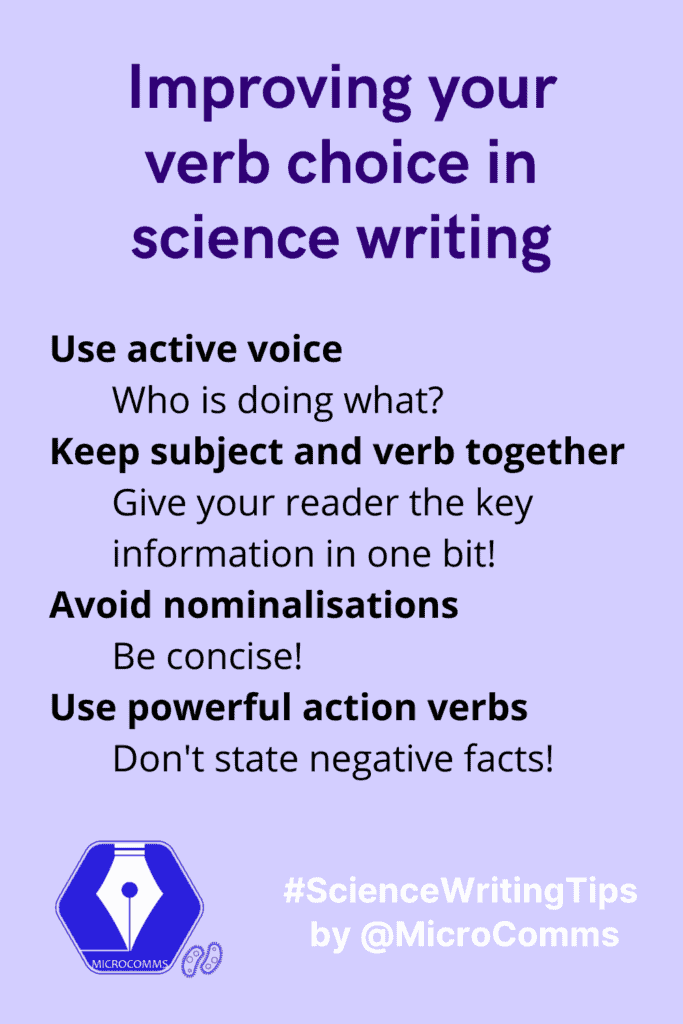You’re writing about your research. You made it your goal to help your reader make sense of the complexity of science. To achieve this, you need to be very clear about the words you use so that your writing conveys the right message.
One important aspect you need to pay attention to when writing your scientific article is the choice of verbs. Verbs are the most powerful part of every sentence. They tell the reader about the action that the key player of a sentence goes through and thus move a story forward.
And yet, in academic writing, many try to avoid using verbs or substitute them with complex constructs. Unfortunately, these often clutter sentences and do not help the reader understand their key messages.
Here, we will look at four basic principles of how you can declutter your science writing articles by improving your verb choice.
Use active voice
To tell your reader that something actually happened (either in the lab or in the system that you are working in), use active voice. Often, researchers are tempted to use passive voice (or should I say they tend to use passive voice?) to describe findings or states. But these phrases do not show any movement and if your language does not move, your reader won’t either.
By using active voice, you tell your reader that the main player does something actively. It moves a story forward by showing that something actually happened.
Also, sentences get shorter by using active voice. Instead of saying that “something is done by someone”, active voice is brief: “someone does something”. So, yes to active voice to declutter your sentences!
For example, commonly written in scientific publications: “Bacterial lipid transporters are used as a mechanism for membrane growth”. This sentence does not have a main player and no real action other than “something is used”. This sentence only states a fact.
How could we improve this sentence to make it more accessible?
You could write in active voice: “Bacteria use lipid transporters to grow their membranes”. Now, this sentence has the main player (bacteria) and they do something (use lipid transporters). This moves a story forward because something happens. Yet, the content is the same as in the first sentence.
Keep the subject and the verb together
In a sentence you generally want to convey the message of someone DOES something (yay active voice!). In this case, your someone is the subject and the action of doing something is the verb.
To efficiently give your reader this information, make sure that your subject and your verb are close together in a sentence. If you split the subject and the action, your reader will have to go through extra information before finding out what actually happens.
For example, look at the sentence “A transcription factor of the nitrogen-fixing soybean endosymbiont Bradyrhizobium japonicum, which responds to the intracellular oxygen concentration, undergoes Clp-mediated regulated proteolysis.” Here, the subject is “a transcription factor” and the action is “undergoes proteolysis”.
Can you see how much information your reader has to read through before getting to the key verb and thus the key message of this sentence? So, keep your subject together with your verb and add all the information afterward. Maybe even split up the sentences to highlight each piece of information.
So, better to write: “The nitrogen-fixing soybean endosymbiont Bradyrhizobium japonicum produces a transcription factor that responds to the intracellular oxygen concentration. This transcription factor also undergoes Clp-mediated regulated proteolysis.” Easier to skim through and understand the two pieces of information.
Avoid nominalisations
Similarly, nominalisations often clutter sentence structures and extend them for no reason. It is better to be clear and brief about the action in a sentence. Instead of saying “make a decision” or “give consideration to”, use the direct verbs: “decide” or “consider”. This is a lot shorter and direct.
For example, often researchers use complicated structures like these: “The transport of the chelator-nutrient complexes into bacterial cells is mediated by TonB-dependent transporters (TBDTs) located at the outer membrane in Gram-negative bacteria.”
It would be a lot clearer to write “TonB-dependent transporters (TBDTs) are located at the outer membrane in Gram-negative bacteria and they transport chelator-nutrient complexes into bacterial cells.”
Now, we still have a passive voice construct (are located), but it is immediately clear WHAT is located where. Plus, your reader will now better understand that TBTDs transport something. This fact did not become clear in the first example because the authors used a nominalisation (transport is mediated) and even separated it by several other words.
Use powerful action verbs
Don’t state negative facts, but rather say what is happening or did happen. This – again – moves a story forward instead of saying how your story did not develop. Otherwise, it will get too confusing for the reader to understand what happened and what did not.
For example, by telling your reader “bacteria did not survive”, they will not understand what actually happened. If bacteria did not survive, what else happened to them?
Here, it is better to write “bacteria died” because now we have one main player (bacteria) and one action (died). Plus, this phrase is a lot shorter while the content is still the same.
Improve your verb choice in science writing
Here, you have four principles of how to choose a better verb in your science writing projects. By following these points, you will help your reader understand your written texts and your key message.

Like this, you will make your science more accessible to everyone – both to scientists and non-scientists.
So, now when editing your texts, pay attention to all the verbs you use in each sentence. Make sure they are clear and powerful action verbs and you don’t use any complex cluttering constructs.
Have you tried these points? Did they work for you? Let us know in the comments below!


One Response